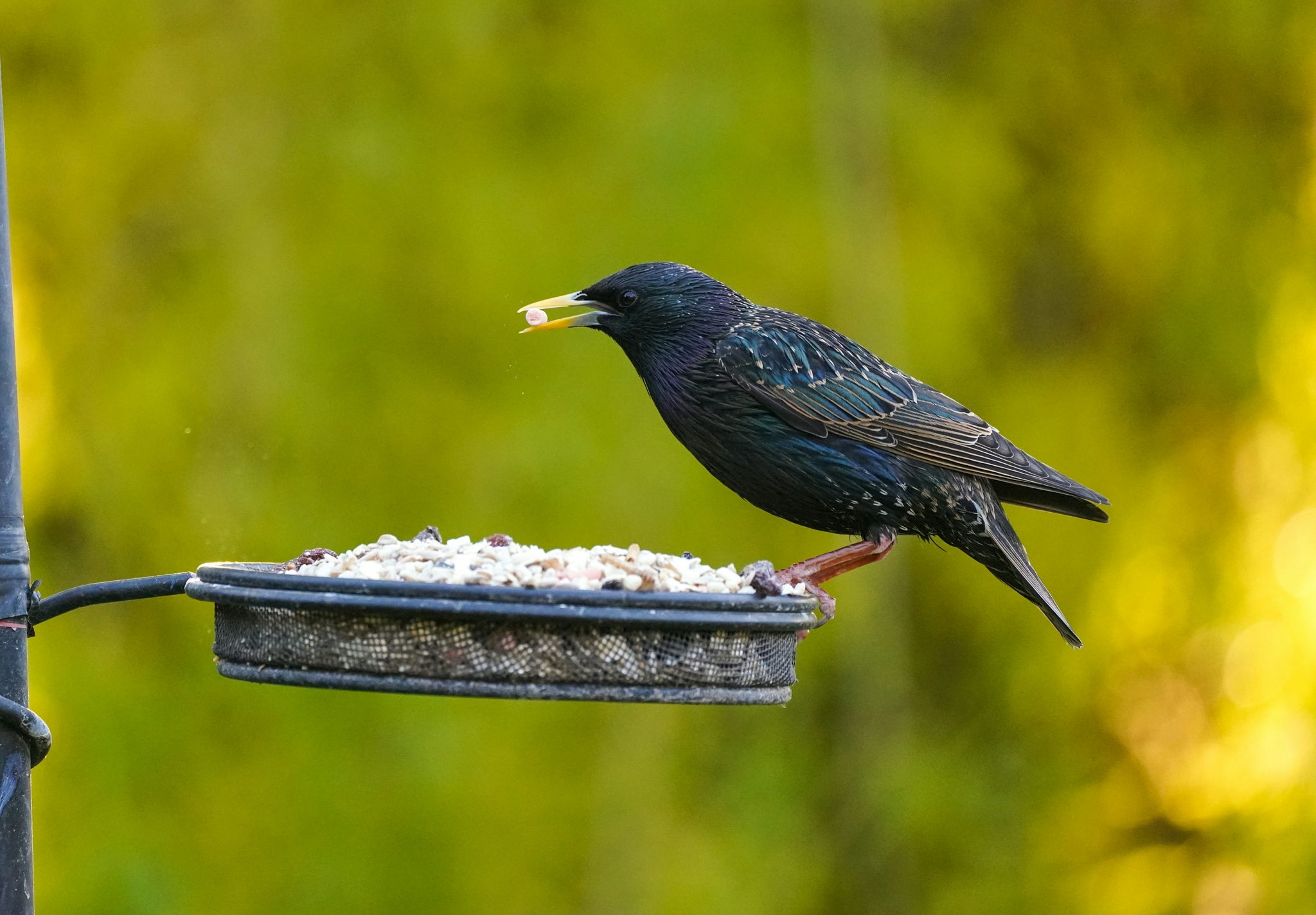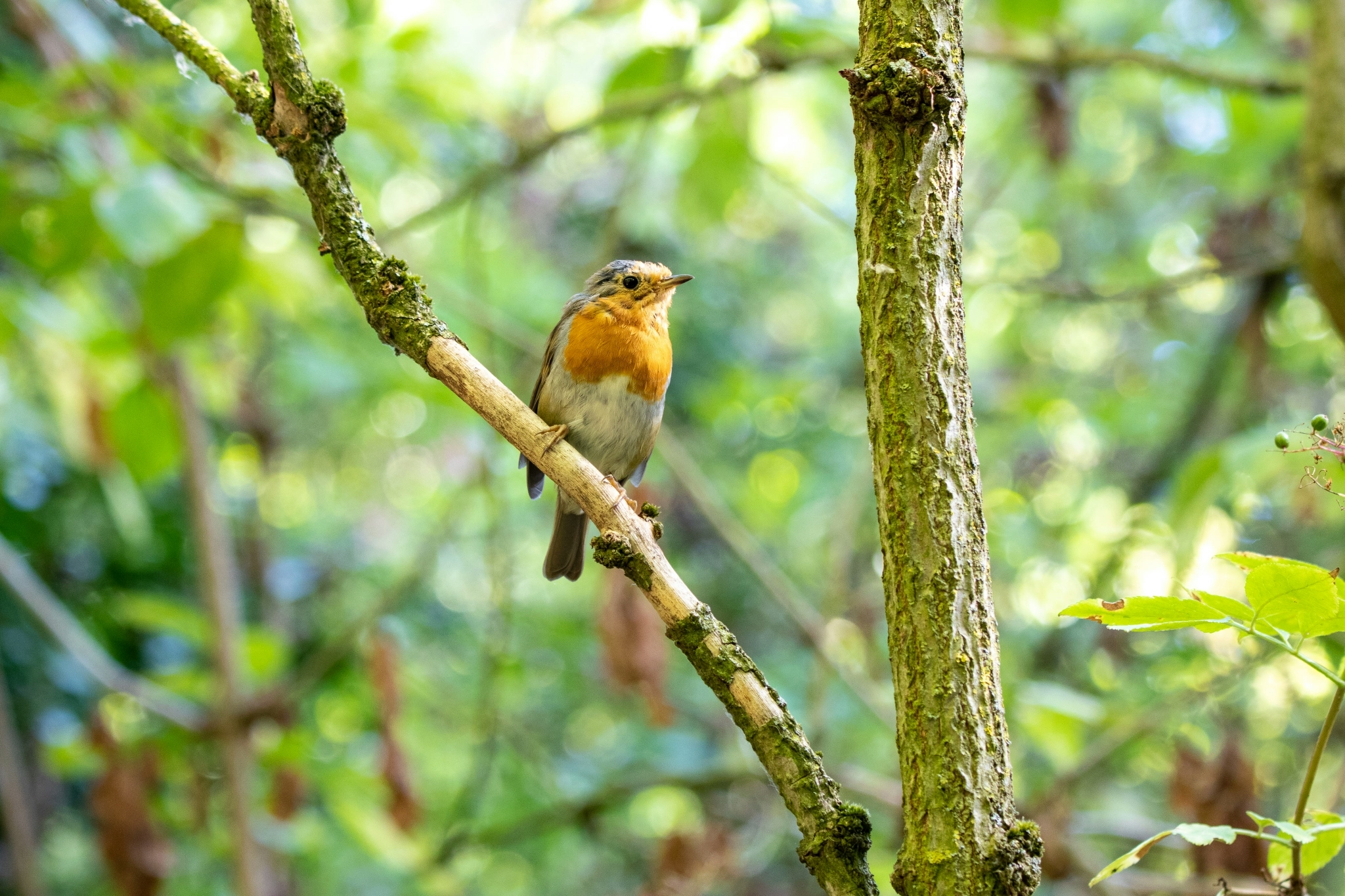WHAT SHOULD I FEED MY GARDEN BIRDS?

A starling eating suet pellets
There are lots of different types of bird food that you can leave in your outdoor space for our feathered friends. Each type attracts different birds, so here’s the low-down.
TYPES OF SCRAN
I’ve been feeding the birds for years, and over that time I’ve accumulated a lot of experience of the different types of bird foods available. Skip to ‘the WINNING FOOD’ if you want to go straight to the best food you can provide.
GENERIC SEED
This basic type of bird food is grain - made up of wheat, maize, and other types of inexpensive seed - usually with some sunflower seeds chucked in for good measure.
YAY: low cost, most widely available, a good all-rounder and good for taking with you to feed the ducks.
NAY: usually involves seeds that grow into grass or wheat, and because birds chuck their food around everywhere, you’ll see sprouts starting to grow below your feeders (and sometimes in the feeder itself), which is annoying if you’re feeding above patio or your prize flower bed.
These beautiful birds LOVE it: wood pigeons, robins, and house sparrows (although most birds will eat it if there isn’t much else around).
Cost: cheap and cheerful!
Method: all-rounder! Put in feeders, on the ground, or on tables.
SUNFLOWER HEARTS
Sunflower hearts are the energy-rich centres of sunflower seeds - they look like little beige chunks.
YAY: a great source of energy for our birds, sunflower hearts are versatile and don’t create any mess
NAY: if they’re the only thing you put out, they don’t tend to attract much variety.
These gorgeous birds LOVE it: goldfinches and tits (also enjoyed by wood pigeons, collared doves, blackbirds and squirrels).
Cost: more expensive than grain, but still relatively low cost.
Method: goldfinches love sunflower hearts in a tall feeder with at least six access points so that they can feed in a group. Other birds will eat it from a tray or from the floor.
NIGER SEEDS
Niger seeds are tiny black seeds (not much bigger than poppy seeds).
YAY: attracts goldfinches, who are delightful.
NAY: the method is a faff, and they’re expensive by weight
These delightful birds LOVE it: my favourite garden birds - collared doves - love niger seeds, as do finches.
Method: As they’re so tiny, you need to put them in a specialist niger seed feeder or a tray without holes.

A goldfinch
FAT/SUET
Fat and suet comes in many forms - blocks, filled coconut halves, suet pellets, and fat balls to name a few.
YAY: fat feeders that are in blocks or balls tend to last a while, and fat and suet attracts different birds to seeds.
NAY: not great for use in hot weather, as they melt or go mouldy. If this is the only thing you’re putting out, you probably won’t get much variety of visitors.
These incredible birds LOVE it: starlings (look for their gorgeous rainbow colours in the sunlight), robins, great tits, blue tits, long-tailed tits and ocassionally magpies.
Cost: varies massively depending on the type, but coconut halves and fat balls are usually cheap.
Method: great low-effort option, as you can just loop the string on the coconut half onto a branch and leave it - no need to top up daily. If you buy fat balls that come in a net you must take them out of the net and put them into a fat ball feeder - the net can injure or kill small birds.

PEANUTS
Peanuts come whole (in their soft brown skin) or ‘kibbled’ into little beige chunks.
YAY: can attract some amazing birds, and they’re high-energy. A side benefit is they’re great for feeding squirrels (if you’re so inclined).
NAY: depending on who visits your garden, you might not get much interest, and this can lead to them going mouldy.
These precious birds LOVE them: blue tits, great tits, sometimes robins and, if you’re super lucky, nuthatches or great spotted woodpeckers!
Cost: cheap and cheerful (kibbled slightly more expensive).
Method: kibbled can go anywhere, but whole peanuts should be put into a specialised feeder.
FRUIT
Lots of bird feed on windfall fruit.
YAY: if you have fruit trees in your garden, leaving the fruit means less work for you picking it up. If you don’t, you can use up fruit that is past its best, reducing waste.
NAY: if not eaten, you’ll be left with mouldy fruit in your garden, which bothers some people.
These wonderful birds LOVE it: blackbirds, thrushes, fieldfares.
Cost: I wouldn’t buy fruit specifically for this - just put your past-best fruit out, cut in half.
Method: just put it on the ground!
MEALWORMS
Mealworms usually come in dried form, although live ones are great during nesting season.
YAY: if you’ve got friendly robins, you can hand feed them with mealworms on your palm.
NAY: they’re expensive!
These great birds LOVE them: robins and other small birds.
Cost: expensive by weight.
Method: leave out on a tray or on the ground. If you put mealworms on the ground, be sure not to put out more than the birds will eat in a day - mealworms make hedgehogs poorly, so we don’t want excess mealworms lying around for them to find.
THE WINNING FOOD
Okay, here’s the secret: buy a mix. Groundbreaking, I know.
Maintaining multiple feeders and multiple types of food is great, but for most people it’s too much admin. I’ve found that the most successful way to get your garden full of birds is the simplest: buy a good quality food mix, put it on a mesh tray above the ground next to some water, and top it up regularly.
I use the ‘no mess mix’ by Peckamix (this isn’t an ad, it’s just the best one I’ve found) - it contains sunflower hearts, suet pellets, and mealworms. Since I swapped to this mix from just sunflower hearts or grain I’ve seen a huge increase in the number and variety of avian visitors. When I put it out in the morning, within ten minutes there are blackbirds, robins, great tits, blue tits, goldfinches, wood pigeons, collard doves, and starlings (and usually a squirrel) - and I live in concrete suburbia. I’ve even had some mallards pop over from the local canal.

A female mallard in my garden
Feeding the birds isn’t all you can do for them - I’ve written about other easy steps to take to help them out.
What do you feed your birds? Who visits your garden? Ever lucky enough to have had a woodpecker or even - if you’re really special - a turtle dove? Let me know!
Share with your friends
Subscribe to learn more
Join me in exploring our natural world and cultural heritage as we learn how to protect and restore it. Get notified on my latest posts and a monthly newsletter on wider conversation topics for us to chat about.
Recent Posts
If you enjoyed this one, then you might like these too.